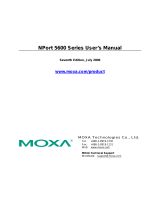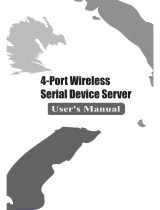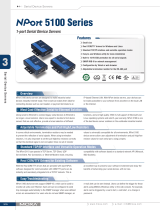
Table of Contents
1. About This Manual ............................................................................................................................. 1-1
2. Getting Started.................................................................................................................................. 2-1
Installing Your NPort Device Server ....................................................................................................... 2-2
Wiring Requirements ................................................................................................................... 2-2
Connecting the Power .................................................................................................................. 2-2
Grounding the NPort Device Server ............................................................................................... 2-2
Connecting to the Network ........................................................................................................... 2-3
Connecting to a Serial Device ....................................................................................................... 2-3
LED Indicators ............................................................................................................................ 2-4
RS-485 Port’s Adjustable Pull High/Low Resistor .............................................................................. 2-6
Configuration by Windows Utility .......................................................................................................... 2-7
Installing NPort Administrator ....................................................................................................... 2-7
Searching for Device Servers over a LAN ........................................................................................ 2-7
Adjusting General Settings ........................................................................................................... 2-8
Configuring Device Port Operation Mode ......................................................................................... 2-9
Configuring Serial Communication Parameters .............................................................................. 2-11
Mapping COM Port to Device (only required when operation mode is set to Real COM or RFC2217) ...... 2-12
Configuration by Web Console ............................................................................................................ 2-15
Opening Your Browser ............................................................................................................... 2-15
Quick Setup (only for the NPort 5000A & NPort IA5000A Series web console) ................................... 2-18
Export/Import (only for the NPort 5000A & NPort IA5000A Series web console) ................................ 2-20
Basic Settings ........................................................................................................................... 2-21
Network Settings ....................................................................................................................... 2-23
Serial Settings .......................................................................................................................... 2-26
Operating Settings .................................................................................................................... 2-29
Accessible IP Settings ................................................................................................................ 2-32
Auto Warning Settings ............................................................................................................... 2-33
Monitor .................................................................................................................................... 2-38
Change Password ...................................................................................................................... 2-40
Load Factory Default .................................................................................................................. 2-41
Configuration by Telnet Console ......................................................................................................... 2-41
Configuration by Serial Console .......................................................................................................... 2-45
Serial Console (19200, n, 8, 1) ................................................................................................... 2-45
Testing Your NPort ............................................................................................................................ 2-48
3. Choosing the Proper Operation Mode ................................................................................................ 3-1
Overview ........................................................................................................................................... 3-2
Real COM Mode .................................................................................................................................. 3-2
RFC2217 Mode ................................................................................................................................... 3-3
TCP Server Mode ................................................................................................................................ 3-3
TCP Client Mode ................................................................................................................................. 3-3
UDP Mode .......................................................................................................................................... 3-4
Pair Connection Mode .......................................................................................................................... 3-4
Ethernet Modem Mode ......................................................................................................................... 3-4
Reverse Telnet Mode ........................................................................................................................... 3-5
Disabled Mode .................................................................................................................................... 3-5
4. Advanced Operation Mode Settings ................................................................................................... 4-1
Overview ........................................................................................................................................... 4-2
List of Parameters ....................................................................................................................... 4-2
When to Make Adjustments .......................................................................................................... 4-2
Using Pair Connection Modes ................................................................................................................ 4-3
Parameter Summary ........................................................................................................................... 4-3
Connection Management Parameters ............................................................................................. 4-3
Data Packing Parameters ............................................................................................................. 4-4
Other Parameters ........................................................................................................................ 4-6
Web Console ...................................................................................................................................... 4-8
5. Configuring NPort Administrator ....................................................................................................... 5-1
Overview ........................................................................................................................................... 5-2
Installing NPort Administrator .............................................................................................................. 5-2
Configuration ..................................................................................................................................... 5-5
Broadcast Search ........................................................................................................................ 5-6
Unlock Password Protection .......................................................................................................... 5-7
Configuring NPort ........................................................................................................................ 5-8
Upgrading the Firmware ............................................................................................................... 5-9
Export Configuration .................................................................................................................. 5-11
Import Configuration ................................................................................................................. 5-12
Monitor............................................................................................................................................ 5-14
Port Monitor ..................................................................................................................................... 5-18





























